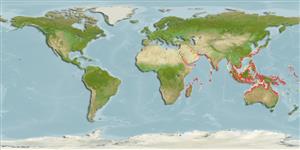>
Kurtiformes (Nurseryfishes, cardinalfishes.) >
Apogonidae (Cardinalfishes) > Apogoninae
Etymology: Archamia: Greek, arche = old + Greek, amia = a kind of fish (Ref. 45335).
Eponymy: Dr Ofer Gon (d: 1949) is a South African ichthyologist who is Senior Aquatic Biologist at the JLB Institute of Ichthyology. [...] (Ref. 128868), visit book page.
More on author: Günther.
Environment: milieu / climate zone / depth range / distribution range
Οικολογία
Θαλασσινό(ά) Υφαλόφιλο(α); εύρος βάθους 10 - 30 m (Ref. 90102). Tropical
Indo-West Pacific: east coast of Africa south to Durban, and eastward to the Gulf of Oman, India, Sri Lanka, Thailand, Singapore, Indonesia, Taiwan, and Queensland.
Μέγεθος / Βάρος / Age
Maturity: Lm ? range ? - ? cm
Max length : 12.6 cm TL αρσενικό/απροσδιόριστο; (Ref. 125969); μεγ. δημοσιευμένο βάρος: 23.20 g (Ref. 125969)
Short description
Κλείδες προσδιορισμού | Μορφολογία | Μορφομετρία
Ραχιαίες άκανθες (συνολικά) : 8; Μαλακές ραχιαίες ακτίνες (συνολικά) : 9; Εδρικές άκανθες: 2; Μαλακές εδρικές ακτίνες: 15 - 17. Color in life silver gray, translucent on body, variable amount of bright yellow pigment on head and body, most commonly on snout, jaws and throat; side of snout sometimes with dark dots; black caudal spot pupil size or smaller; fins pale; diffuse orange stripe above anal-fin base. Rays: dorsal rays VII,9; anal II,15-17 (usually 16); pectoral 14 (rarely 13 or 15). Lateral line scales 25 + 3-4; median predorsal scales 5-6 (rarely 5). Gill rakers 5-7 + 15-18. Body depth 2.6-3.2 in SL; body width 2.2-2.8 in depth; eye diameter 2.7-4.4 in HL; first dorsal spine 1.1-1.4 in second spine; second dorsal spine 2.2-3.0; third dorsal spine 2.3-3.0 in HL; spine of second dorsal fin 2.6-3.1, and second anal spine 3.4-4.5 in HL; pelvic-fin length 4.5-5.8, and caudal-peduncle length 4.5-5.4 in SL. Distance from insertion of pelvic spine to anal-fin origin 4.5-5.7 in SL. Preopercular edge smooth except for serrae at angle and on posterior half of ventral edge. Scaly sheath along anal-fin base poorly developed.
Found in coastal, mangrove zones and thought to enter rivers, but also found with shipwrecks in deeper water laying on muddy substrates (Ref. 48635); also on reefs, over sandy and muddy bottoms in silty conditions (Ref. 54391) Forms aggregations that hover above rocky outcrops (Ref 90102). Feeds on fish eggs and larvae, shrimps, and pelagic polychaetes (Ref. 31551).
Life cycle and mating behavior
Γεννητική Ωρίμανση | Αναπαραγωγή | Γεννοβολία | Αβγά | Γονιμότητα | Προνύμφες
Are mouthbrooders (Ref. 240). Distinct pairing during courtship and spawning (Ref. 205).
Gon, O. and J.E. Randall, 2003. Revision of the Indo-Pacific cardinalfish genus Archamia (Perciformes: Apogonidae), with description of a new species. Indo-Pac. Fish. (35):49 p. (Ref. 54391)
IUCN Red List Status (Ref. 130435: Version 2024-2)
Threat to humans
Harmless
Human uses
Εργαλεία
Special reports
Download XML
Διαδικτυακές πηγές
Estimates based on models
Preferred temperature (Ref.
123201): 25.1 - 29.1, mean 28.2 °C (based on 620 cells).
Phylogenetic diversity index (Ref.
82804): PD
50 = 1.0000 [Uniqueness, from 0.5 = low to 2.0 = high].
Bayesian length-weight: a=0.00977 (0.00582 - 0.01642), b=2.95 (2.81 - 3.09), in cm total length, based on LWR estimates for this species & (Sub)family-body (Ref.
93245).
Τροφικό Επίπεδο (Ref.
69278): 3.7 ±0.51 se; based on food items.
Ελαστικότητα (Ref.
120179): Υψηλό, ελάχιστος χρόνος για διπλασιασμό πληθυσμού < 15 μήνες (Preliminary K or Fecundity.).
Fishing Vulnerability (Ref.
59153): Low vulnerability (10 of 100).
Nutrients (Ref.
124155): Calcium = 146 [72, 253] mg/100g; Iron = 1.11 [0.63, 1.95] mg/100g; Protein = 18.5 [17.3, 19.7] %; Omega3 = 0.129 [0.069, 0.235] g/100g; Selenium = 30.3 [14.7, 62.9] μg/100g; VitaminA = 90.9 [28.3, 308.7] μg/100g; Zinc = 1.57 [1.00, 2.33] mg/100g (wet weight);
